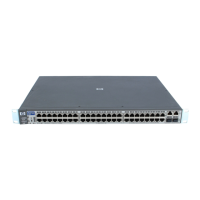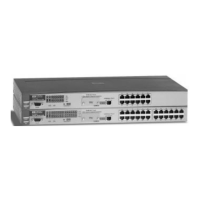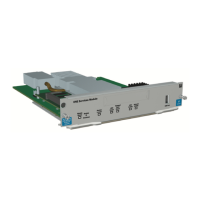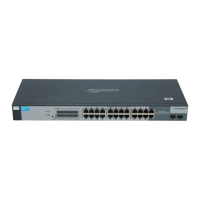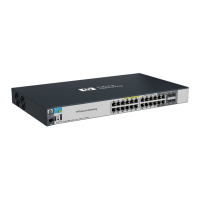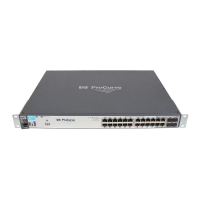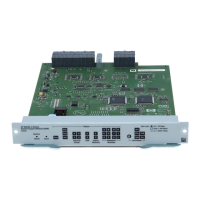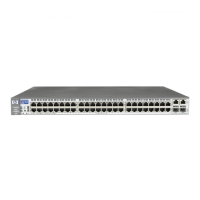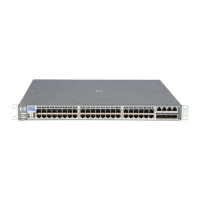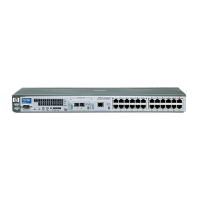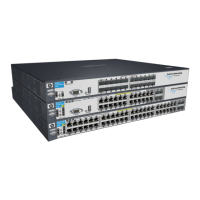
Do you have a question about the HP ProCurve Series and is the answer not in the manual?
| Series | ProCurve |
|---|---|
| Category | Switch |
| Ports | Varies by model |
| Port Speed | Varies by model |
| Switching Capacity | Varies by model |
| Forwarding Rate | Varies by model |
| Power Supply | Varies by model |
| Management | Web, CLI, SNMP |
| VLAN Support | Yes |
| Layer | Layer 2 or Layer 3, varies by model |
| Jumbo Frame Support | Yes |
| Dimensions | Varies by model |
| Weight | Varies by model |
Covers installation and initial setup for ProCurve 3500yl and 6200yl switches.
Explains the Power over Ethernet functionality supported by the switches.
Provides disclaimer and warranty details for the product.
Highlights essential safety and environmental guidelines before installation.
Details the components and LEDs located on the front of the switches.
Describes the ports and connectors found on the rear of the switches.
Outlines the key capabilities and functionalities of the ProCurve switches.
Lists the components that are shipped with the ProCurve switches.
Provides a step-by-step guide for installing the ProCurve switches.
Highlights essential safety and environmental guidelines for installation.
Details the function and behavior of switch port LEDs.
Describes the 10/100/1000Base-T ports on the switch.
Explains the dual-personality ports and their connectivity options.
Details the status indications of Power, Fault, and Locator LEDs.
Explains the function of Port LEDs for link status and mode.
Describes the LED Mode Select button and its indicator lights.
Explains the function and use of the reset button on the switch.
Details the purposes of the clear button, like deleting passwords.
Describes the LEDs specific to the expansion module.
Describes the yl module slot on the back of the switch.
Details the RPS and EPS input ports for power supply.
Identifies the location of the AC power connector on the switch.
Explains the function and connection of the console port.
Provides information on the switch's power connector and auto-voltage.
Lists the components that are shipped with the ProCurve switches.
Ensures the cabling infrastructure meets network specifications.
Describes LED behavior while the switch is performing self test.
Details LED status upon successful completion of the self test.
Explains how to mount the switch in a rack or cabinet.
Details how to connect network cables using RJ-45 ports.
Explains how to connect network cables to mini-GBIC ports.
Provides steps for connecting a fiber optic network cable.
Provides steps for connecting a copper network cable.
Details the operating characteristics of the 620 RPS/EPS.
Explains the status LEDs for the 620 RPS/EPS unit.
Guides on configuring terminal settings for console connection.
Illustrates a common network setup using the switch as a desktop device.
Outlines the essential steps for an initial switch configuration.
Provides guidance on next steps after initial configuration.
Explains how to recover from a lost manager password.
Guides on how to start a Telnet session for switch management.
Explains how to access the switch via a web browser interface.
Provides instructions for replacing the switch's fan tray assembly.
Offers fundamental advice for resolving common network issues.
Explains how to interpret switch LED patterns to diagnose problems.
Details methods for testing the switch's hardware and operating code.
Guides on resetting the switch to its original factory default settings.
Information on how to contact HP support for assistance.
Lists physical dimensions, weight, and electrical requirements.
Outlines operating and non-operating temperature and humidity limits.
Details acoustic properties, connector standards, and safety compliance.
Provides information on the laser classification of the transceivers.
Provides an overview of the switch's port types and capabilities.
Details specifications and wiring for twisted-pair network cables.
Lists specifications for various fiber-optic cables used with the switches.
Information on mode conditioning patch cords for Gigabit-LX.
Provides pin assignments for twisted-pair cable connectors.
Covers essential safety guidelines, grounding, and servicing precautions.
Details compliance statements for electromagnetic compatibility across regions.
Information on the proper disposal of electronic waste according to WEEE directives.
